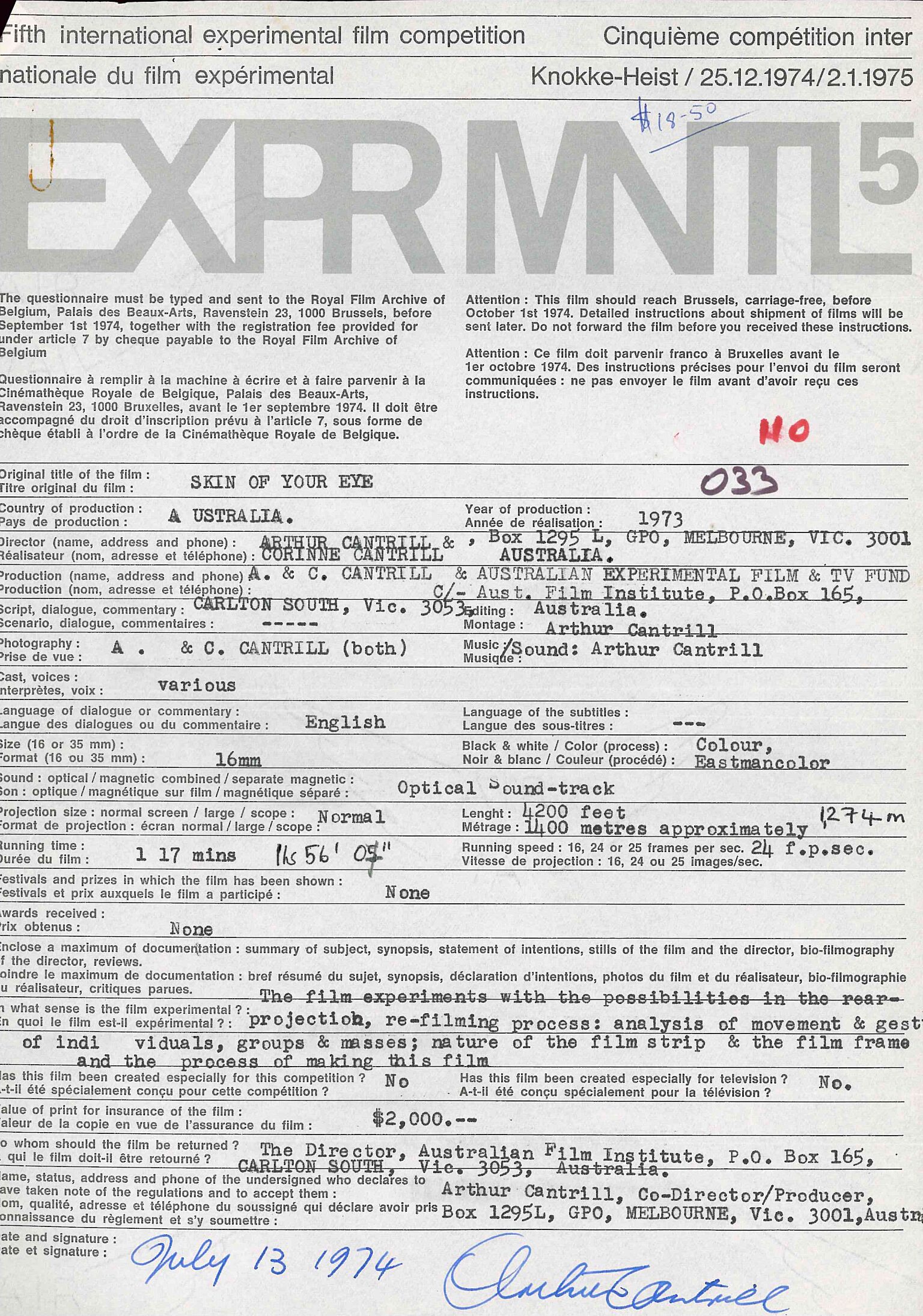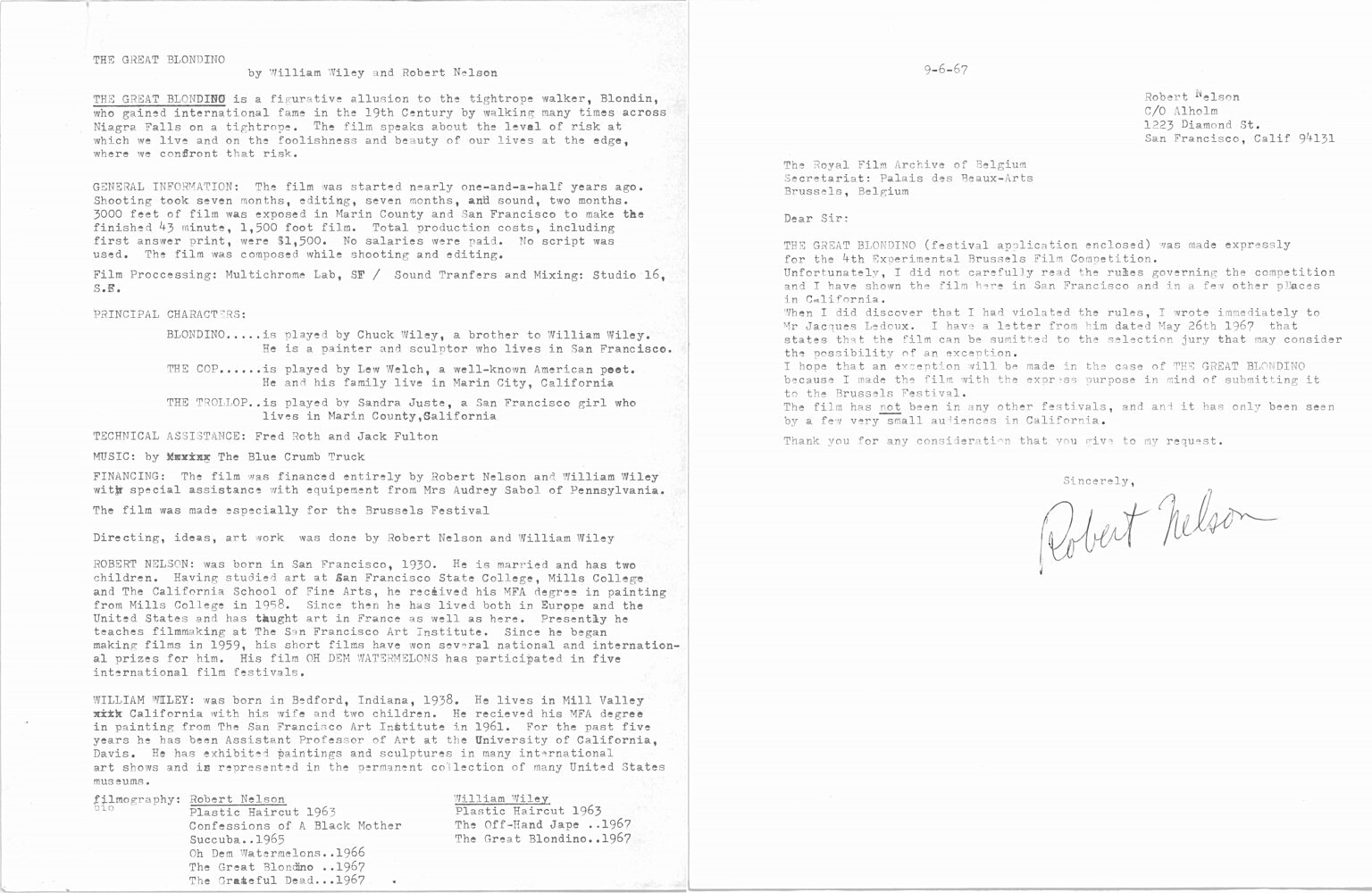The Cantrills at Knokke EXPRMNTL

Cantrills dossier for EXPRMNTL 5
By the time Arthur and Corinne Cantrill visited Knokke in 1967 for the fourth edition of the infamous and unique EXPRMNTL festival, they had already been making films for several years. Beginning in the early sixties, the first years of their filmmaking lives saw them engage with a more traditional form of documentary-filmmaking, often portraying children and their creativity and imagination–as seen in Making Window Pictures (1966) and Adventure Playground, London (1966) in Early Movements, the first instalment of the Moving Statics-cycle which focuses on the early filmmaking efforts of the Australian duo. During their arrival in Knokke in 1967 and the years following, they were primarily engaged with making art documentaries, turning their camera towards artists Robert Klippel, Charles Lloyd, Henri Gaudier-Brzeska and Will Spoor. Considering Arthur was also a sound artist, it’s not a surprise that their practice in the mid-sixties increasingly delved into the avant-garde through experiments with sound. Seeing Michael Snow’s Wavelength and having a long talk with Yoko Ono at EXPRMNTL responded to their growing interest on this topic and affirmed their approach to sound, as Arthur later recounted.
The Cantrills spoke about visiting Knokke in 1967 often, calling it “a turning point in our filmmaking lives”. Their 1968 film Red Stone Dancer–a study of one of Henri Gaudier-Brzeska’s most famous sculptures–was a direct tribute to their experience at the event. Many years later, Corinne remembered seeing the work of “Robert Nelson, Gunvor Nelson, Will Hindle, Paul Sharits; really powerful films from Germany and Austria, from Japan, and from England - Stephen Dwoskin, Malcolm Le Grice, Don Levy, Yoko Ono”. Corinne’s memory may not have been a hundred percent accurate, recounting fifty years after the event, given there is no mention of Hindle, Le Grice or Levy in the official program of EXPRMNTL 4. However, it’s not completely out of the question that their work was indeed shown at the festival, as numerous films were shown outside of the main competition.
In any case, the work of another filmmaking couple, Robert and Gunvor Nelson, was definitely part of the (official) program. Robert Nelson showed two films, The Great Blondino (made with William T. Wiley) and The Grateful Dead while Gunvor Nelson premiered Fog Pumas, a film she made with Dorothy Wiley and which won them a prize at the festival. These films had a decisive impact on Arthur and Corinne, so it feels very fitting to show The Great Blondino and Fog Pumas alongside Red Stone Dancer and Henri Gaudier-Brzeska (two films the Cantrills made immediately after visiting Knokke) in the third program of this series, The Knokke Connection. In the first issue of the Cantrills Filmnotes (1971), Arthur talks about acquiring ‘New American Cinema' prints for the archive in Australia, which includes The Great Blondino. That first edition of the magazine also has a piece specifically on The Great Blondino, as well as a published letter from Robert Nelson to Corinne and Arthur.
Both Fog Pumas and The Great Blondino were made specifically for the Knokke festival, as documents in the EXPRMNTL archive in the CINEMATEK show. In their submission files for the festival, both gave a ‘note of intention’ of their film:
The Great Blondino: This is a long film that uses no specific narrative development. Its coherence depends on deeper non-verbal sensibilities. The Great Blondino is a figurative allusion to the tightrope walker, Blondin, who gained international fame in the 19th Century by walking many times across Niagara falls on a tightrope. The film speaks about the level of risk at which we live and on the foolishness and beauty of our lives at the edge, where we confront that risk.
Fog Pumas: Strange places in the filmmakers mind mixed with strange places in reality make a third place on film. The subject of the film is that third place. The continuity is built on subjective emotional logic. My only intention was to make a film I like.


Gunvor Nelson about Fog Pumas for EXPRMNTL
Although they considered their experience at EXPRMNTL 4 to be life-changing, Arthur and Corinne did not shy away from critiquing some of the institutional aspects of the festival, especially the awarding of prizes at the end of the festival. In the Cantrill Filmnotes issue 14/15, they reflect on the festival within a broader context of experimental film festivals being organized as competitions: “The unpleasant fact is that once you submit to a competition you compromise yourself and your work. You give a power of superiority to the administration and the judges of the competition - who simply do not know more than the filmmakers. The results tell us more about the judges than the state of film”. The article questions whether EXPRMNTL might be the exception to the rule, acknowledging it is “absolutely a filmmakers’ festival”. They write:
Unfortunately, Knokke is also organized as a competitive festival: this is how they get funds to run it. All the earlier criticisms of competitive festivals must hold for Knokke. There is this difference: a vast amount of work shown out of competition, and one has more respect for the judges. Last time they nominated Michael Snow’s important film WAVELENGTH for the Grand Prix. Knokke also has a worthwhile alternative to giving prizes to particular films - they often give a prize to a filmmaker on the basis of his body of work shown. It’s one thing to say this is the best film, and another to say here is a prize for a fine body of work you have shown us.
The article anticipates the fifth edition of EXPRMNTL, seven years after Arthur and Corinne first came to know the festival and Jacques Ledoux. The Australians did not attend the final edition in 1974, to their own disappointment. However, they were able to show their film Skin of Your Eye, a full-length film of 116 minutes which continues their experiments with the process of re-filming and the interaction between rear-projected image, screen, camera, projector, filters, light and the filmmakers. In Skin of Your Eye, this strategy is extended into fifteen film essays on Melbourne. Every essay is concerned with a particular aspect of the filming process: the relationship of projector, screen, camera, the film strip of positive or negative, the coloured gelatin filter, the film frame, the projector gate, the projector lens, the projected image on to the screen and the blackness around.
Skin of Your Eye was shown out of competition which–given their critique of the competitive nature of the festival–was probably to their liking. In a letter to Jacques Ledoux just days before the start of the festival, they reiterated their critique, declaring it is “against the spirit of the creative individual, and out of keeping with new social and ethical values of the Alternative culture movement with which many experimental filmmakers are spiritually associated”. They advocated for the festival to accept and show all submitted films. They ended the letter by stating that the only reason they decided to enter was due to the Australian Film Institute agreeing to pay the entry fee and submitting their print of Skin of Your Eye.

Cantrills dossier for EXPRMNTL 5
In the years that followed, Arthur and Corinne continued to keep in touch with Jacques Ledoux, exchanging numerous letters about including work in the CINEMATEK archive–next to Skin of Your Eye, Ledoux bought a print The Second Journey (To Uluru) (1981) and Waterfall (1984) for the archive–and about potential screenings of their work at CINEMATEK. Many of these attempts proved to be unsuccessful. Ledoux wrote “We do not have an audience for these kinds of films in Brussels,” adding “Personally, I do love them very much but they do not seem to have resonance among an untalented audience”.
In February 1994, six years after the passing of Jacques Ledoux, Arthur and Corinne were finally able to show a large portion of their work inside the walls of the CINEMATEK. Titled Filmexprmntl: short films by Arthur and Corinne Cantrill, the program revived the spirit of their pivotal encounter with EXPRMTNL. Almost sixty years after Arthur and Corinne’s filmmaking lives took a different turn at the shore of Belgium, Art Cinema OFFoff – in collaboration with Australian programmers Keegan O’Connor and Audrey Lam – further unearths this special connection of the Belgian festival with two of Australia’s most singular filmmakers. The four-program cycle concludes not in Knokke, but at the CINEMATEK, where the print of Skin of Your Eye has been stored since it was first, and probably last, shown in 1974, together with numerous archival materials that preserve physical traces of a long and personal exchange.

The prizes for EXPRMNTL 4




